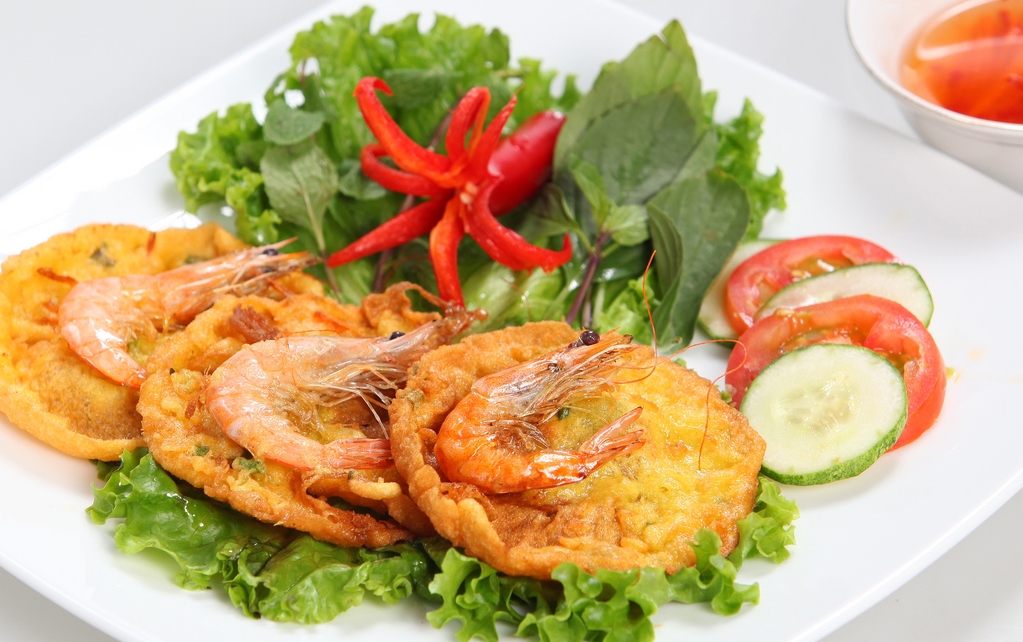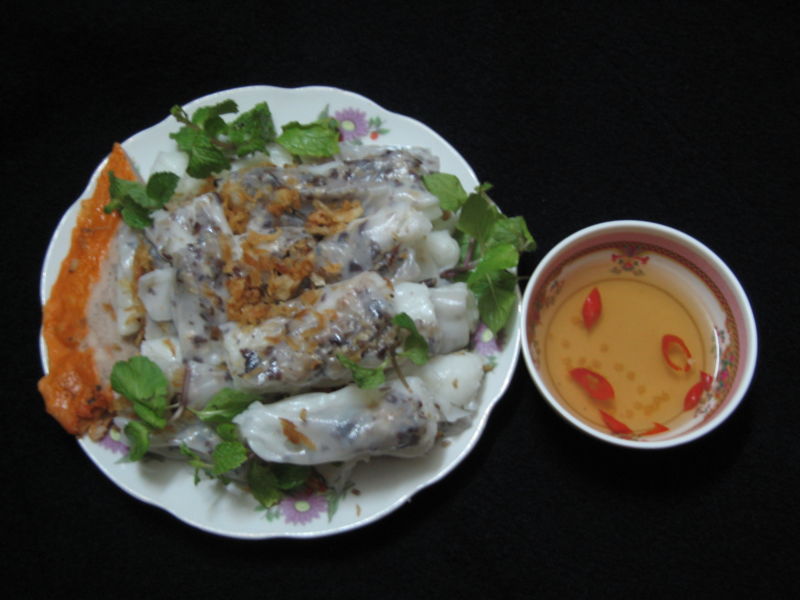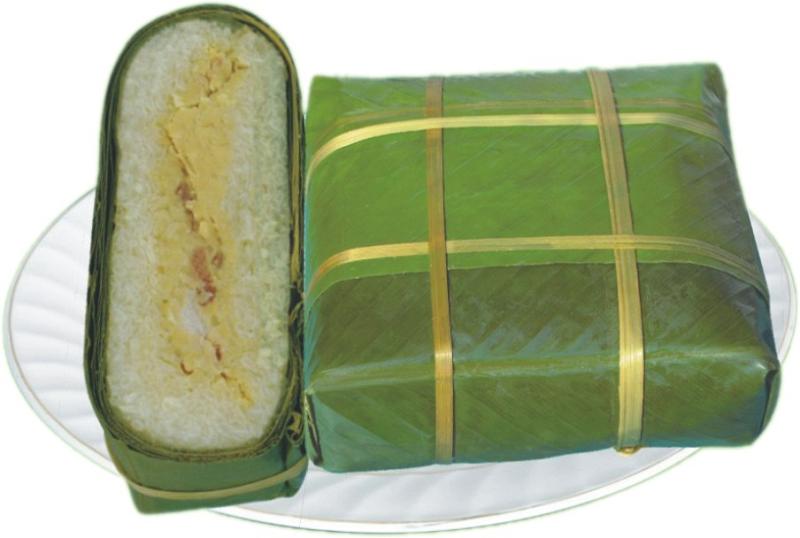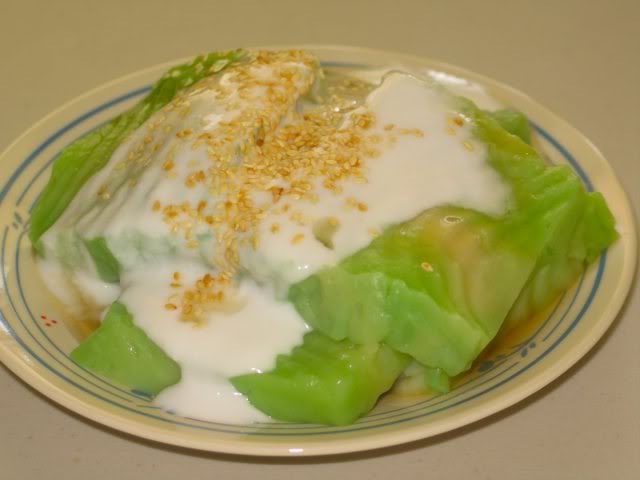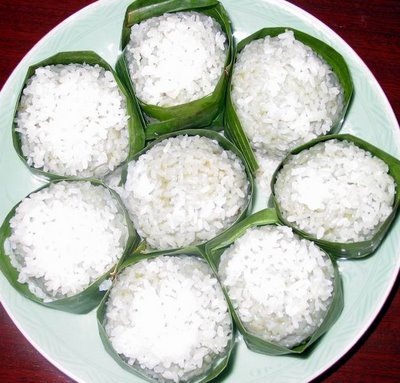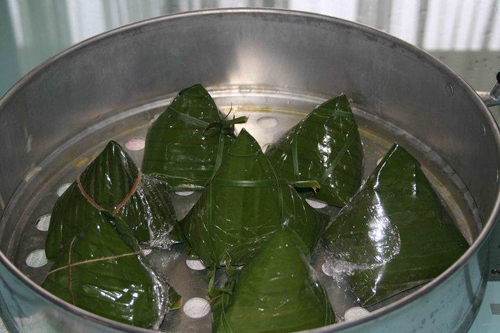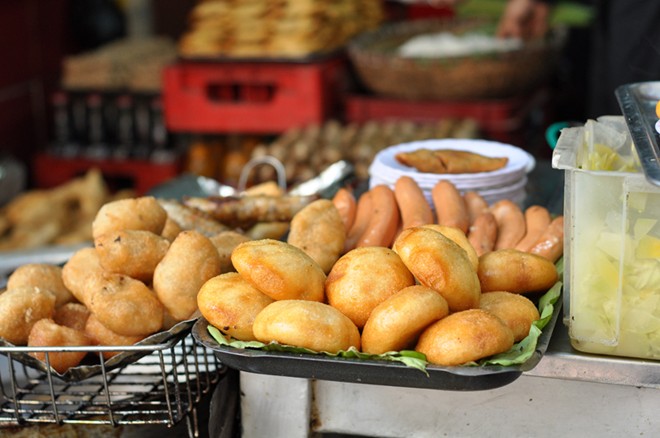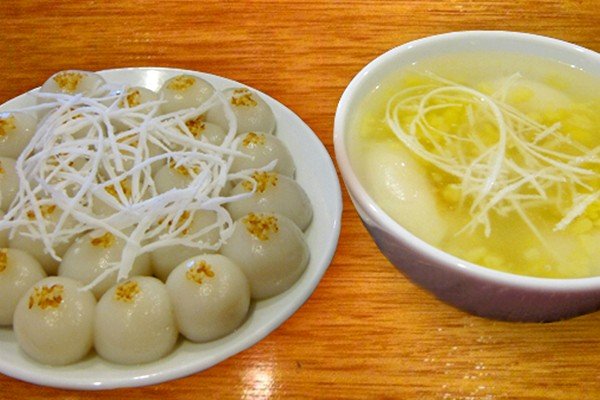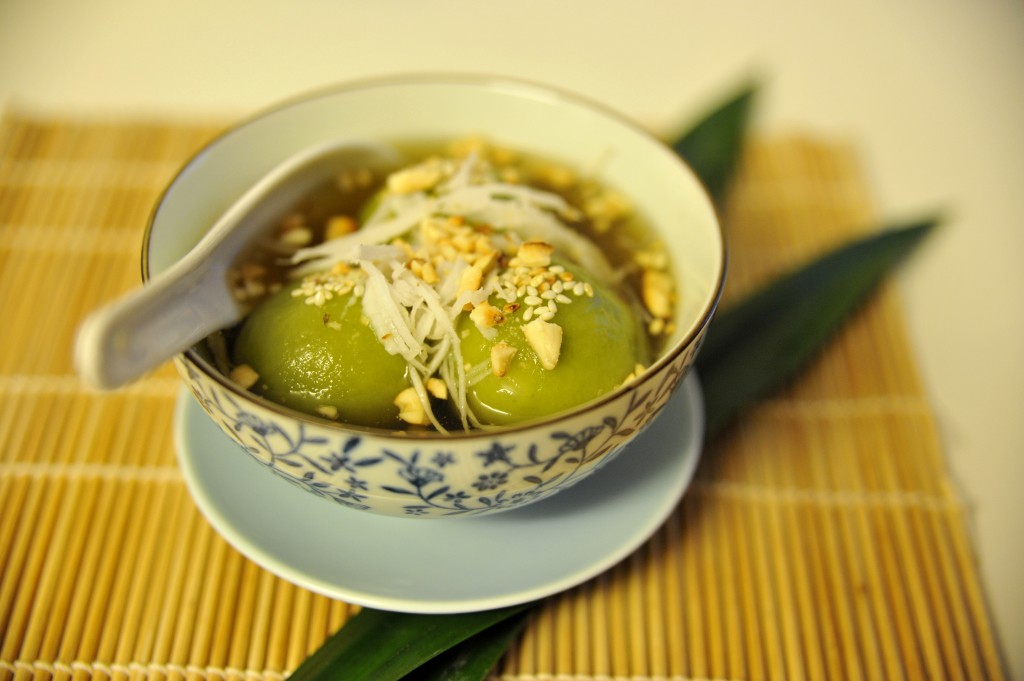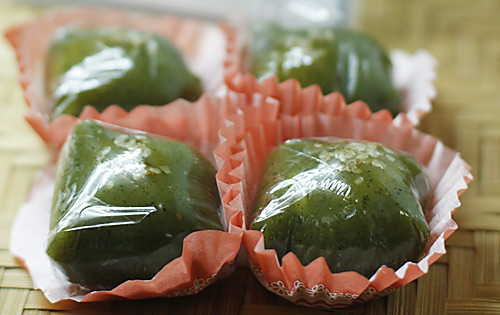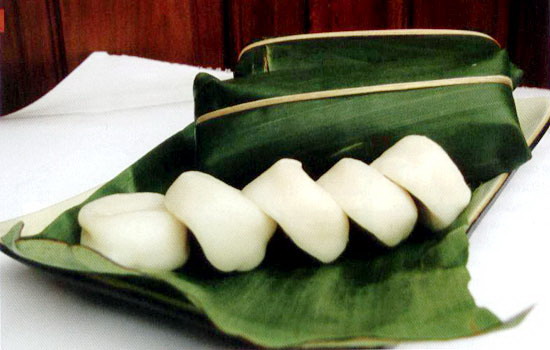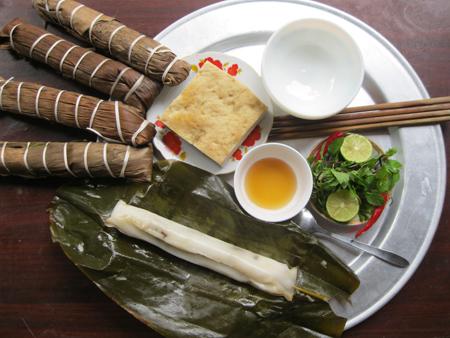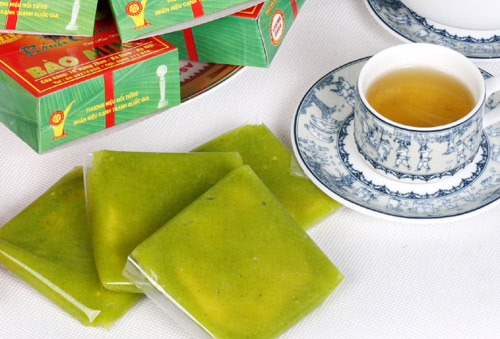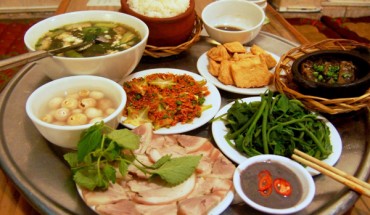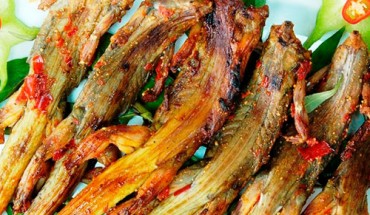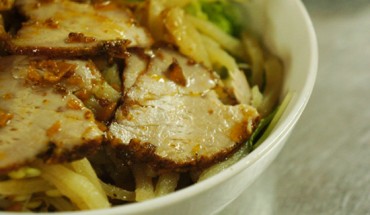Banh – Cakes
In the old days, in the end-of-the-year tray of offerings of the Hanoi People, there should not be without the tray of cakes with brightly red momordica cakes, the colorful ‘9 cloud levels ‘cakes, To Chau cakes, Manh Cong cakes, snow white beets, purple potato ‘beef’ cakes… Not sophisticated, brilliant, the small pretty cakes are like wrapping up the responsibility and skillfulness of Trang An girls. Each kind of cake has its own flavor, a unique delicacy which cannot be confused with one another.
Banh Tom Ho Tay – West Lake Shrimp Cakes
Anyone who has been to Hanoi once will certainly be eager to find his way to West Lake shrimp cakes once to have a chance to enjoy the unique specialty of this land. The cakes are called West Lake shrimp cakes, but the place to make and sell this exclusive kind of cakes lies by Truc Bach bank, separated with West Lake by Thanh Nien road. In the past, there were several low, simple tents which both sold shrimp cakes and beer. Now West Lake shrimp cakes are served in an imposing building of several hundreds of seats, gleaming in the shade of banyan trees which is shady cool and windy. The way of making shrimp cakes seem to be simple. Flour, adding some sour sift flour, a little of baking powder, a little of curry saffron powder, mixed with water so that it is very thick. Fresh shrimp antennas are cut, cleaned. The fat frying pan is well-heated, putting the paste into the moulds, topping with one or two prawns, then dip them in. After several minutes, the shrimp cakes will emerge, waiting a moment so that the cakes are well-done, taking them out to dry the fat then bringing them out to serve the customers. Saying so simple like that but this job requires a lot of painstaking. How much power quantity is enough, the water amount is little or a lot, keeping the shrimps to be fresh, the flame of the furnace is hot so that the cakes are not so rare but not burnt off…
That is the know-how of the restaurant. The sauce of shrimp cakes is nearly similar with that of rice noodle and grilled pork; there should be enough sour, hot, salty and sweet tastes. But it should be just enough, so that they blend into each other into such a delicious sauce that drinking it alone one can finish a whole bowl of sauce. The restaurant should have its own recipe for making the sauce, making the same sauce for many years now. Shrimp cakes are sold as per portion. A dish of cakes, accompanied by a dish of salad vegetables put in the middle of the table, each person has his own bowl of sauce putting in front of him. Looking at the dining table of shrimp cakes one can see the harmony of colors. The yellow cakes with the bright red shrimps are highlighted on the background of white ceramic enamel. The young, green lettuce, the dark green herbs. In the bowl of sauce emerge pieces of thinly-sliced green white papaya interspersed with bright red slices of chili. West Lake shrimp cakes – a simple kind of snack – also contribute to create a particular characteristic for Thang Long- thousand-year land of historical festivals.
Banh Cuon Thanh Tri – Thanh Tri Rolling Cakes
Once you have been familiar with eating rolling cakes in Hanoi, if we go and eat rolling cakes in other places, we will see that Hanoi rolling cakes, in particular Thanh Tri rolling cakes, there is nowhere to criticize it.
It is very meticulous to prepare the ingredients to make rolling cakes. The flour to make the cakes should be made from high quality kind of rice so that the cakes are not too pungent, the cake appearance will be white. Cooking and spreading the cake should be very thin; the fat rubbing onto the cake should be even so that the cake surfaces are smooth so that when we taste it it is fine and cool Putting on the center of the cakes should require good skills so that the cakes do not look rough; the center is even in all the cakes.
When eating, the cakes are striped off gently every thin layer by the setter; they are then rolled and put onto the dishes. The gently fragranced cakes, smooth are dipped into a tiny bowl of fish sauce then when putting them into our mouth; we will see a whole rhythmic combination. The aroma of the cakes, the centers are mixed with the hot salty and sweet taste of the sauce, adding several drops of belostomatid essence.
With such a way of selling the food, only a basket carrying on the head, the old ladies and women in Thanh Tri area go all around the streets to cry for their product. The vendors treat customers with kindness and consideration and are ready to put the basket of rolling cakes onto the pavements or in the street hamlets for several cyclo drivers, some other vendors of different kinds of food. Selling like that eating like that but it is delicious, very delicious and it is not confused with any other kind of rolling cakes. In the old days, when eating Thanh Tri rolling cakes, people often add several very hot and very swollen fried piece of tofu However, today perhaps eating rolling cakes like that Is too delicate; people add some luxurious roasted cinnamon pork. Hanoi rolling cakes nowadays have a variety of kinds and have become a cheap but delicious breakfast snack. Some kinds are eaten cold, other kinds are eaten hot some kinds have meat inside some kinds have chicken eggs inside some kinds do not have center inside. Each kind offers a particular taste However, people still remind of Thanh Tri rolling cakes as a product of popular gastronomy art of Hanoi capital people.
Banh Chung Uoc Le – Uoc Le ‘Chung’ Cake
‘Chung’ cakes – square glutinous rice cakes are a kind of traditional cakes of Vietnam nation in order to express the gratitude of the offspring towards their father and grandfather generations and the local heaven and earth. The ingredients to make the cake includes glutinous rice, green beans, pork, Dzong leaves and the cake is usually made during Vietnamese traditional Tet holidays, as well as Hung Vuong ancestor anniversary (March 10th lunar calendar).
Uoc Le village (Tan Uoc commune, Thanh Oai district, ‘ Hanoi) is not only known for the traditional career of making lean pork paste, grilled pork paste but also where the famous delicious ‘Chung’ cakes are made. The ‘Chung” cakes made in the traditional ‘Chung’ cakes traditional making professional Uoc Le village, Thanh Oai distict on the occasion of Nham Ngo traditional Tet holidays (2002) is the biggest ‘Chung’ cake by that time. The cake weighed 1. 4 tons made by 50 craftsmen of Uoc Le vil lage with 330 kg of glutinous rice, 100 kg of green beans, 100 kg of pro, wrapped with 1, 500 Dzong leave and cooked in a steel cooker over 2m high in over 72 hours.
Banh Duc – ‘Cast’ Cakes
To have a delicious piece of ‘cast’ cake coming up to the diners is quite a painstaking process. The delicious cake batch depends on the stage of selecting high quality ordinary rice. Then, the rice is soaked for 3 days and nights, each day it is changed of water until the rice can be crushed into powder with fingers then it is mixed with clear lime water.
‘Cast’ cake without being put in with pea-nuts is chopped into small threads or in stripes as small as a finger, eating with peanut broth, fresh salad vegetables, it is called sweet and sour grated salad, bean shoot ‘cast’ cakes.
If the diner does not like ‘cast’ cake with broth, they can order dipping ‘cast’ cakes. Cakes of ‘cast’ cakes with peanuts inserted are broken into pieces, dipping in ‘Ban’ soya sauce is a very unique way of enjoying.
It is the sweet taste of soya sauce crispy and fatty of ‘cast’ cakes has pulled the diners away from the bustle atmosphere of downtown streets to come for the simple gentle feeing of the countryside.
Banh Khuc Xu Doai – Doai Village Khuc Cakes
After the peasants harvest the season rice crop; the cold wind fooling around in the field signaling winter is coming. It is at this moment that Khuc vegetables have grown up – a small “plant” often grows in ploughed beds, the silt area by the gentle rivers of Doai village (Hanoi). In the countryside areas of Doai village, making Khuc cakes is very popular in the leisure after harvest time. They make the cakes just for fun, as gifts for the elderly, giving to children and selling to customers from other places visiting the beautiful sights of their hometown. There are two kinds of Khuc cakes that is steaming cakes and boiling cakes. The steaming cakes look flat round, not wrapped in leaves and the boiling cakes are nearly similar to ordinary rice cakes and wrapped in Dzong leaves.
Once eating can people feel the delicacy of Khuc cakes, both crispy, viscous and nutty of beans, buttery of meat and especially the so strange fragrance, very special the typical taste of Khuc vegetable plants which no other taste can be compared with; one can just exclaim that “Khuc cakes are actually a kind that contains the green field flavor of the rural area” Doai local people have to go on business away from home; when hearing about the North eastern monsoon blows violently or when they see “the wind blows through the fragranced field and all оvеr the sky swallows glide, the trees grow full of green buds, ” their hearts will certainly feel agitated, anxiously гemembering about their hometown, missing the season of Khuc vegetables and the taste of Khuc cakes which are simple but strongly bearing the gastronomy sense of their hometown.
Banh Gio – Pryamidal Rice Dumpling
(Fill with meat, onions, mushrooms)
Pyramidal rice dumplings are a kind of traditional cakes of the Hanoian. Pyramidal rice dumplings are light food, snack, usually eaten hot. Not like ‘square’ cakes, pyramidal rice dumplings always have one kind, one shape: pyramidal rice dumplings are wrapped humped and it should certainly be wrapped with banana leaves.
Eating pyramidal rice dumplings is not when one feels starving or when he is in a rush. It is not like the rural ‘cast’ cake, not like bread that one can walk and chew it at the same time; it is totally different from stir-fried beef noodle soup, rare beef noodle soup, sauté beef noodle soup, chicken noodle soup…
Once people eat pyramidal rice dumplings, they should chew them moderately, the piece of cake is both hot and soft, hot but still have cool taste at the tip of the tongue, sweet as the center is made of pork, fragranced because of fried onion and fat, taste is changed because of wood ears… can they feel this kind of snack is interesting, both elegant and delicious but it is not expensive. Pyramidal rice dumplings also do not need such spices fish sauce, chili, and pepper. The cake itself has enough spices. If customers like, they can eat ‘gio’ dumpling with grilled chopped fat pork pie, tiny cube pomegranate seed-shaped meat pie; cinnamon meat pie which is the kind of meat pie rolled onto big-size bamboo tube and grilled over charcoal without having to boil, or lean pork paste, beef pork paste… to enhance the flavor for Hanoi capital’s pyramidal rice dumplings.
Banh Ran Ha Noi – Glutinous Rice Doughnuts
Glutinous rice doughnuts are made in many places in the North, and they are usually made in winter. Glutinous rice doughnuts are available in Ha Noi all year round, but eating it in winter is the most suitable, and perhaps that is also the place where there are the most delicious glutinous rice doughnuts.
Scattered everywhere in Ha Noi there are many places that sell glutinous rice dough-nuts. The brown yellow cakes, so fragranced that one can feel hungry immediately and customers are attracted by the skillfully prepared sauce.
There are many kinds of glutinous rice doughnuts in traditional gastronomy, typically are glutinous rice doughnuts with red center, with the appearance is molasses sweetened glutinous rice doughnuts, sweetened glutinous rice doughnuts and sesame glutinous rice doughnuts.
There are in fact glutinous rice doughnuts cross-bred with ‘pillow’ cakes, eating with chili sauce which is now usually called salty glutinous rice doughnuts and glutinous rice doughnuts with red and black center, sesame center, and coconut center.
The feeling is being able to bite the pieces of doughnuts which have just been fried, hot during the cold winter. Just only that, but it will make you clear off the unfinished hungry outburst in the middle of the day and make winter therefore warmer…
Banh Troi Banh Chay – Floating Cakes And Lean Cakes
For each Hanoian person, the Third lunar month’s third day’s festival or it is also called the floating cakes and lean cakes Tet holidays, this Tet holiday occurs on the third day of the third lunar month, when the heaven and earth is mixed in the warm Spring weather with the sunlight and new wind. Before that for several weeks, the Hanoian people go to the market; select and buy glutinous rice, green beans, a kilogram of sugar, a hundred piece of sugar candies, a couple of taels of sesame, tapioca flour and they can bring further a coconut fruit home and protect it carefully. The ingredients for making floating cakes, lean cakes need only that, simple but of no less importance.
Although the society is modem, life has many changes but the cultural values, traditional beauty of the customs of making floating cakes lean cakes on the third lunar month’s third day’s festival is still handed down through the generations of the Hanoian people.
Today, one can eat floating cakes & lean cakes at anytime, not necessarily having to wait until the third lunar month’s third day’s festival.
Banh Troi Tau – The Warm Chinese Floating Cakes
The warm Chinese floating cakes have for a long time become a popular; familiar of the Hanoian each time autumn appears. In the coldness, coolness of autumn weather, Chinese floating cakes become a snack to warm hands.
The ingredients for making the cakes are countryside green field ingredients: glutinous rice flour, green beans, fresh ginger, peanuts, coconuts, black sesame… That is why Chinese floating cakes become so closed, familiar – it is the snack of the cool autumn days, cold winter days.
Enjoying the hot sweet bowl of floating cakes with the viscous glutinous rice skin, with the center of soft green beans, a little of fragranced, nutty black sesame and sniffing the warm aroma of ginger mixed with the sweet taste of the hot boiling broth, the diners will see their hearts warm up.
In the cool weather of autumn together with the fragranced milk flowers, the sweet smell of magnolia is the warmth of Chinese floating cakes – a very particular flavor capable of holding the feet of any diners.
Banh To Chau – To Chau Cakes
Like beet cakes, To Chau cakes are a kind of sweet cakes which are loved by the old Hanoi Capital people. To Chau cakes are made from ordinary rice powder mixed with green bean flour, sugar, minced pork, grapefruit perfume, wood ears, field mushrooms and sesame. All of these ingredients are mixed well then cooked it half way through then stuffing the half-cooked paste into the greased moulds then steamed until it is well-do- ne. Leaving the cakes to cool then cut them into Pieces small enough to eat.
Banh Cu Cai – Beet Cakes
Beet cakes are one of the traditional dishes of the old Hanoian. It has the soft, sweet, cool taste and suitable to use with tea.
Just like To Chau cakes, beet cakes are made from ordinary rice powder, green bean powder, scraped beets, sugar, fat and grapefruit perfume. In order to make delicious cakes, the makers have to select young beets then scrape them very thin, wash them so as to drive away the smell; after that it is mixed with different kinds of flour, water, sugar, minced fat, grapefruit perfume then cook it half way through. Put the half-cooked paste into the greased moulds then steam them until they are well-done then cut them into pieces like To Chau cakes.
Banh Manh Cong – Manh Cong Cakes
Manh Cong cakes are one of the aged-old dessert dishes of the Hanoian. Today this kind of cakes has been recovered and will be popularized in the near future. Manh Cong cakes are made from glutinous rice powder and crushed Manh Cong leave water. The center of the cake is well-cooked green beans then crushed until it is fine and soft then stir-fries it with dry preserved squash and sugar.
To make the cake skin, Manh Cong leave water is mixed with sugar and flour then cooked half way through on the cooker then takes it off, shape it into separate dumplings then wrap them in glazed paper then steam them.
From the old days, Manh Cong cakes were a favorite kind of dessert of the Hanoian family used when drinking with green tea.
Banh Day Quan Ganh – Quan Ganh ‘Day’ Cakes
Quan Ganh ‘day’ cakes are one of traditional specialties of the hundred-career land of Hanoi. Quan Ganh Village belongs to the area of Thuong Tin town. For several hundred years now ‘day’ cakes of the village are always seen as a popular but delicate kind of cakes of Vietnam gastronomy.
Quan Ganh village’s rice cake has a fragranced vicious taste of steamed glutinous rice, the green color of banana leaves, the nutty fragrance of beans; meat is mixed with other ingredients that only people from Quan Ganh can make those characterized flavors.
Stopping feet to enjoy the delicious ‘day’ cakes, passers-by are also attracted by the handed down story about the origin of ‘day’ cake making career in Quan Ganh village. The story in the past seems to float in the air in the fragrance of the vicious steamed glutinous rice, making customers still attached to it. If you do not have a chance to go through Quan Ganh village, you can find the carrying baskets of ‘day’ cakes of the women from Quan Ganh village to peddle in the streets of Ha Noi.
Banh Gai Ke Gia – Ke Gia ‘Thorn’ Cakes
Thorn cakes are a kind of sweet cakes available from the old days, being ranked as one of the traditional kind of ethnic cakes; while ’Chung’ cakes, ‘Day’ cakes symbolizing for heaven and earth, thorn cakes symbolizes for human. Thus on Lunar Tet holidays, opening for a new year, Vietnamese people make that kind of cakes to make offerings to heaven and earth, ancestors to express gratitude and wish for a good new year.
In Ha Noi, ‘thorn’ cakes are made a lot in Doai village area. Most typically is Ke Gia ‘thorn’ cakes (now includes Yen So, Dac So, Yen Thai belonging to Hoai Duc district Ha Noi). Ke Gia thorn’ cakes have many distinctive differences from the ‘thom’ cakes of other locations in the whole country, like a kind of brand name, only Ke Gia has. The ingredients to make thorn cakes are chosen carefully, including yellow flower large-size glutinous rice; sugar paste, glutinous ‘thorn’ leaves (not ordinary ‘thorn’ leaves), coconut leaves, pork fat refined sugar, peanuts, sesame…
The stage of making thorn cakes is very sophisticated, but to let the cakes have their own flavor, the makers have to add further coconuts… Coconut in the center is available in Hai Duong, Nam Dinh ‘thom’ cakes. But only in Ke Gia is there a particular kind of flavor of coconut – which is grown and primarily processed right at the locality.
So that ‘thom’ cakes are delicious, having typical flavor, their own brand name, the importance is how to process the ingredients to be enough, so that it is not only delicious, nutty, viscous, fragranced but also beautiful strange. This way of processing bears traditional confidential characteristic Ke Gia ‘thom’ cakes have reached that quality and it is not easy for ‘thom’ cakes from other regions to have because of the high quality, particular taste; and beautiful models.
Banh Tro Dac So – Dac So Tro Cakes (‘Ash’ Cakes)
Holding the cake which is wrapped closely in one’s hands, gently unbind the little rope then peel off the layer of Dzong leaves, we will see the pretty cake having a clear brown yellow color, glittering to the degree that we can see the shape of yellow flower big-size glutinous rice expanding evenly appears. That is ‘Tro’ cake (ash) – a kind of snack which has been a popular but unique gastronomy specialty in Dac So (Ke Gia), Hoai Duc district (Ha Noi). Going to Dac So in the transitional weather from spring to summer, enjoying the glossy and fair dish of ‘Tro’ cake being poured in with some sweet sugar cane molasses, tourists will feel dearly the viscous aromatic taste of the rice seed interspersed a little with the acrid flavor of glutinous rice straw ash water mixed with the gentle, cool sweetness of sugar, sugar cane clumps and the skillfulness embedded in the way of making this simple kind of country- side snack. Not only to enjoy in the family or offering to guests for a try when they visit the house but ‘Tro’ cakes are also brought to sell widely by Ke Gia people in markets, street hamlets and some traditional restaurants in downtown the Capital.
The ingredients to make ‘Tro’ cakes are very simple, including: glutinous rice, ash water of clean glutinous rice straw stripes, a little lime, banana leaves or Dzong leaves and sugar cane molasses. All are very simple, familiar agricultural produce of the farmers’ production. In Dac So, there are hardly any families which do not know how to make ‘Tro’ cakes. In the village festival day, Tet holidays or more simple in the dinner party offering to guests, Dac So people usually have a cool aromatic dish of ‘Tro’ cakes to be used as desserts. There are households which make the cakes all year round and directly go to sell them or serve the orders of some restaurants, hotels which amount to nearly 10 households.
It is not a luxurious dish, however, the dish of Dac So ‘Tro’ cakes is so glossy and fair, soft and shiny of yellow brown color up till now is still a kind of simple but fine, aromatic country snack which are loved by the Hanoian -Trang An.
Banh Te Phu Nhi – Phu Nhi Rice Cakes
Phu Nhi, Son Tay town – Ha Noi, is famous with kind of cake which is very popular, that is rice cakes. Anyone who has visited Phu Nhi has certainly enjoyed the snow white, aromatic bearing the gastronomy characteristics of that Doai area.
Each locality has its own way of making rice cakes, more or less different However, Phu Nhi rice cakes bear its particular flavor which is not confused with other regions.
The ingredients to make the cake are those familiar with the farmers’ lives such as ordinary rice, pork, wood’s ear, onion… and Dzong leaves, banana leaves to wrap the cakes. The cakes eat the best when they have just been taken out from the boiler. Peeling off the green leaves of the cake, the white cake appears, the fragrance of pork center disperses as if it is inviting the guests. The cakes are eaten hot and dipped into high-quality fish sauce, adding some pepper then it is more delicious.
Rice cakes are a kind of simple, honest countryside snack, the kind of cakes that anyone can enjoy. When eating people use a small knife to cut the cakes into small pieces and arrange them onto the dish. Eat one bite to feel the combination of spirit of heaven and earth, the crispiness of the cake skin, the strong, fat taste of the center, aromatic of pepper, onion. The cakes can be eaten for breakfast eat for fun, eat a lot without feeling bored.
Banh Com Hang Than – Hang Than Green Rice Flake Cakes
The old Hanoian thought of many ways to enjoy green rice flakes, the green rice flakes are mixed with lean pork, crushed, fry as meat pie to eat with aromatic Tam high quality rice. Green rice flakes are stir-fried with white refined sugar, which can be kept as long as weeks. Refining cooking powder mixed with white refined sugar then pour in with green rice flakes, cooking until boiling as a kind of dessert made with sugar and grilled rice but sweet and fine… Finally, the forefather of Nguyen Duy family in Hang Than street thought of another way, which is to dry green rice flakes, processed it into green rice flake cakes.
Also with glutinous rice with green beans but the flavor of green rice flake cakes is different from any kind of cakes. The green rice flakes are made from young glutinous rice, the center includes green beans and coconut. Both skin and center of the cake is stir- fried with sugar, when enjoying the cake it is difficult to know which part is more delicious.
Than Street, there are dozens of shops which produce and sell green rice flake cakes but Nguyen Ninh is the traditional green rice flake cake shop which are favored by many people.
These are the most famous traditional cakes in Hanoi. Please click here to see more information about Vietnam Guide or Tours in Vietnam.


